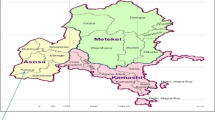Abstract
The aim of the present study was to evaluate the microbial contamination of domestic swine carcasses over an 8-year period in a slaughterhouse located in the Marche region, Central Italy. The hygiene of the slaughter process was assessed by microbiological criteria involving aerobic colony count (ACC), Enterobacteriaceae and Salmonella spp. [Regulation (EC) No 2073/2005 and amendments]. Five carcasses were tested during five sampling sessions each year (four different sites from each carcass were pooled before the analysis) for a total of 200 samples. The results of the study showed low levels of ACC and Enterobacteriaceae and the absence of Salmonella spp., except for one sample. The values of ACC were consistently satisfactory (< 3.3 Log CFU/cm2), whereas Enterobacteriaceae counts were satisfactory for 32.5% (< 1.3 Log CFU/cm2) and acceptable for 67.5% (with values between 1.3 and 2.3 Log CFU/cm2) of the examined samples. The low microbial counts detected on the carcasses reflected the initial visual examination of animal “cleanliness” [Regulation (EC) No 853/2004] as well as the hygiene conditions of the slaughtering process. These results suggest that the management of this specific slaughterhouse apply good hygiene practices to ensure high quality animal carcasses.


Similar content being viewed by others
References
Biasino W, De Zutter L, Mattheus W, Bertrand S, Uyttendaele M, Van Damme I (2018) Correlation between slaughter practices and the distribution of Salmonella and hygiene indicator bacteria on pig carcasses during slaughter. Food Microbiol 70:192–199
Corbellini LG, Júnior AB, de Freitas Costa E, Duarte AS, Albuquerque ER, Kich JD, Cardoso M, Nauta M (2016) Effect of slaughterhouse and day of sample on the probability of a pig carcass being Salmonella-positive according to the Enterobacteriaceae count in the largest Brazilian pork production region. Int J Food Microbiol 228:58–66
EFSA (2008) Report of the task force on zoonoses data collection on the analysis of the baseline survey on the prevalence of Salmonella in slaughter pigs, Part A. EFSA J 135:1–111
EFSA (2011) Scientific Opinion on the public health hazards to be covered by inspection of meat (swine). EFSA J 9(10):1–198
FSA (Food Standards Agency) (2004). Clean beef cattle for slaughter. A guide for producers. Food Standards Agency, Crown Copyright, England, 5 k FSA/0951/1104
Intesa Rep. Atti n. 41/CSR del 3 marzo (2016) Intesa, ai sensi dell’articolo 8, comma 6, della legge 5 giugno 2003, n. 131, tra il Governo, le Regioni e le Province autonome di Trento e di Bolzano sul documento concernente “Linee Guida relative all’applicazione del Regolamento (CE) N. 2073/2005 e successive modifiche ed integrazioni sui criteri microbiologici applicabili agli alimenti”, pp 1–41
ISO 17604:2003 (2003) Microbiology of food and animal feeding stuffs—Carcass sampling for microbiological analysis. International Organization for Standardization, Geneva
ISO 21528–2:2004 (2004) Microbiology of food and animal feeding stuffs—Horizontal methods for the detection and enumeration of Enterobacteriaceae—Part 2: Colony-count method. International Organization for Standardization, Geneva
ISO 4833:2003 (2003) Microbiology of food and animal feeding stuffs—Horizontal method for the enumeration of microorganisms—colony-count technique at 30 °C. International Organization for Standardization, Geneva
ISO 6579:2002 (2002) Microbiology of food and animal feeding stuffs—Horizontal method for the detection of Salmonella spp. International Organization for Standardization, Geneva
Martínez-Avilés M, Garrido-Estepa M, Álvarez J, de la Torre A (2019) Salmonella surveillance systems in swine and humans in Spain: a review. Vet Sci 6(20):1–16
Milios KT, Drosinos EH, Zoiopoulos PE (2014) Food safety management system validation and verification in meat industry: carcass sampling methods for microbiological hygiene criteria—a review. Food Control 43:74–81
Paolazzi G, Rabini M, Borghi M, Oberkalmsteiner E, Pontalti S, Vedovato L, Lombardo D (2018) Autocontrollo nei macelli in provincia di Bolzano nel biennio 2016-2017: applicazione del Regolamento CE No 2073/2005. Atti XXVIII Convegno Nazionale A.I.V.I. (Associazione Italiana Veterinari Igienisti). Milano 12–14 settembre 2018, P013, pp 29–30
Pesciaroli M, Cucco L, De Luca S, Massacci FR, Maresca C, Medici L, Paniccià M, Scoccia E, Staffolani M, Pezzotti G, Magistrali CF (2017) Association between pigs with high caecal Salmonella loads and carcass contamination. Int J Food Microbiol 242:82–86
Petruzzelli A, Osimani A, Pasquini M, Clementi F, Vetrano V, Paolini F, Foglini M, Micci E, Paoloni A, Tonucci F (2016) Trends in the microbial contamination of bovine, ovine and swine carcasses in three small-scale abattoirs in central Italy: a four-year monitoring. Food Microbiol 111:53–59
Piras F, Fois F, Mazza R, Putzolu M, Delogu ML, Lochi PG, Rani SP, Mazzette R (2014) Salmonella prevalence and microbiological contamination of pig carcasses and slaughterhouse environment. Ital J Food Saf 3(4581):210–213
Swart AN, Evers EG, Simons RL, Swanenburg M (2016) Modeling of Salmonella contamination in the pig slaughterhouse. Risk Anal 36:498–515
Van Ba H, Seo HW, Seong PN, Kang SM, Cho SH, Kim YS, Park BY, Moon SS, Kang SJ, Choi YM, Kim JH (2019) The fates of microbial populations on pig carcasses during slaughtering process, on retail cuts after slaughter, and intervention efficiency of lactic acid spraying. Int J Food Microbiol 294:10–17
Van Damme I, Mattheus W, Bertrand S, De Zutter L (2018) Quantification of hygiene indicators and Salmonella in the tonsils, oral cavity and rectal content samples of pigs during slaughter. Food Microbiol 71:120–128
Wheatley P, Giotis ES, McKevitt AI (2014) Effect of slaughtering operations on carcass contamination in an Irish pork production plant. Irish Vet J 67(1):1–6
Zdolec N, Dobranic V, Filipovic I (2015) Prevalence of Salmonella spp. and Yersinia enterocolitica in/on tonsils and mandibular lymph nodes of slaughtered pigs. Folia Microbiol 60:131–135
Author information
Authors and Affiliations
Corresponding author
Ethics declarations
Conflict of interest
The authors declare they have no conflict of interest.
Additional information
Publisher's Note
Springer Nature remains neutral with regard to jurisdictional claims in published maps and institutional affiliations.
Rights and permissions
About this article
Cite this article
Visciano, P., Schirone, M., Olivastri, A.M.A. et al. Levels of microbial contamination of swine carcasses along the slaughtering process line. J Consum Prot Food Saf 15, 271–276 (2020). https://doi.org/10.1007/s00003-020-01276-z
Received:
Revised:
Accepted:
Published:
Issue Date:
DOI: https://doi.org/10.1007/s00003-020-01276-z




